Related Research Articles

The cicadas are a superfamily, the Cicadoidea, of insects in the order Hemiptera. They are in the suborder Auchenorrhyncha, along with smaller jumping bugs such as leafhoppers and froghoppers. The superfamily is divided into two families, the Tettigarctidae, with two species in Australia, and the Cicadidae, with more than 3,000 species described from around the world; many species remain undescribed.
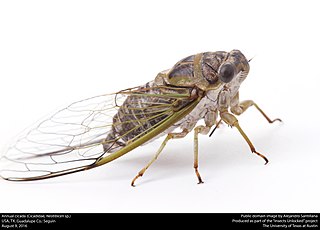
Cicadidae, the true cicadas, is the largest family of cicadas, with more than 3,200 species worldwide. The oldest known definitive fossils are from the Paleocene, a nymph from the Cretaceous Burmese amber has been attributed to the family, but could also belong to the Tettigarctidae.

Cicadas of the genus Neotibicen are large-bodied insects of the family Cicadidae that appear in summer or early fall in eastern North America. Common names include cicada, harvestfly, jar fly, and the misnomer locust. In 2015, these species were moved from the genus Tibicen, which was redefined in the twenty-first century to include only a few European species, while species from the Western United States and Mexico are now placed in a separate genus, Hadoa. In addition, several former Neotibicen species have been moved to the genus Megatibicen.
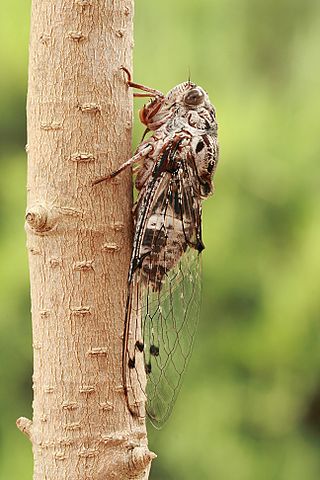
Aleeta curvicosta is a species of cicada, one of Australia's most familiar insects. Native to the continent's eastern coastline, it was described in 1834 by Ernst Friedrich Germar. The floury baker is the only described species in the genus Aleeta.

Cryptotympanini is a tribe of cicadas in the family Cicadidae. They are found in the Nearctic, Palearctic, Indomalaya, Oceania, and Afrotropics.
Xhosores is a genus of wrinkled bark beetles in the family Carabidae. Xhosores figuratus, found in South Africa, is the only species of this genus.
Megatibicen auletes commonly, but informally called the northern dusk-singing cicada, giant oak cicada, or southern oak cicada, is a species of cicada in the family Cicadidae. It is found in the eastern United States and portions of southeastern Canada.
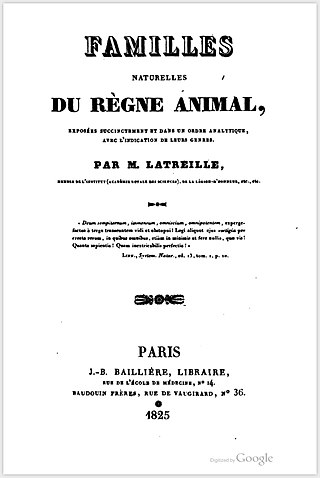
Tibicen is a historical genus name in the insect family Cicadidae that was originally published by P. A. Latreille in 1825 and formally made available in a translation by A. A. Berthold in 1827. The name was placed on the Official Index of Rejected and Invalid Generic Names in Zoology by the International Commission on Zoological Nomenclature in 2021. Certain European cicada species that were included by some authors in this genus at the time of its suppression are now listed under genus Lyristes Horváth, 1926. Other formerly-Tibicen species are placed in the tribe Cryptotympanini and include the genera Auritibicen Lee, 2015, Hadoa Moulds, 2015 Megatibicen Sanborn and Heath, 2016, and Neotibicen Hill and Moulds, 2015.
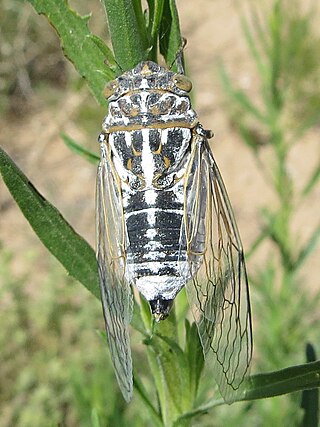
The genus Hadoa comprises large-bodied Cicadidae occurring in Western North America. Until recently, these species were in the genus Tibicen, which has now been redefined so as to include only a few European species, while most species from the Eastern and Central US are now placed in Neotibicen and Megatibicen.
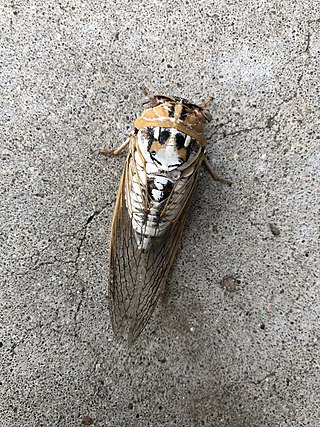
Megatibicen dealbatus, commonly called the plains cicada, is a species of annual cicada. Dealbatus is Latin for "whitewashed".

Megatibicen dorsatus, known generally as the bush cicada or giant grassland cicada, is a species of cicada in the family Cicadidae.

Megatibicen is a genus of cicadas in the family Cicadidae, with about 10 described species. Until 2016, these species were included in the genus Tibicen and then briefly in Neotibicen. The species formerly of genera Ameritibicen Lee, 2016 and Gigatibicen Lee, 2016 are now considered species of Megatibicen Sanborn & Heath, 2016.
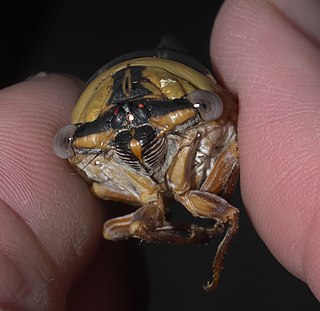
Megatibicen pronotalis, or Walker's cicada, is a species of cicada in the family Cicadidae. It is found in the northern Great Plains of the United States.

Megatibicen tremulus, known generally as the western bush cicada or Cole's bush cicada, is a species of cicada in the family Cicadidae. It is found in the Great Plains of the United States, often associated with Sagebrush.
Cornuplura is a genus of cicadas in the family Cicadidae. There are at least three described species in Cornuplura.
Beameria is a genus of cicadas in the family Cicadidae. There are at least three described species in Beameria.
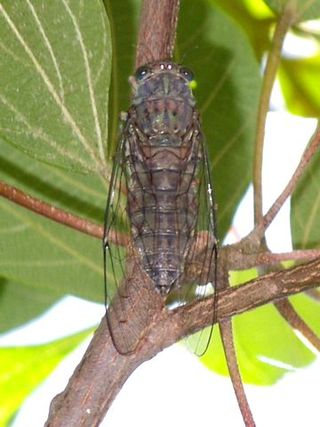
Leptopsaltriini is a tribe of cicadas in the family Cicadidae. There are at least 200 described species in Leptopsaltriini, found in the Palearctic, Nearctic, and Indomalaya.

Oncotympanini is a tribe of cicadas in the family Cicadidae, found in China and southeast Asia. There are at least 3 genera and about 12 described species in Oncotympanini.

Megatibicen resh, the resh cicada or western dusk singing cicada, is a species of cicada in the family Cicadidae, found in North America.

Lyristes is a genus of cicadas from Europe and the Middle East. It was described by G. Horvath in 1926.
References
- ↑ "Megatibicen figuratus". NCBI. Retrieved 24 July 2021.